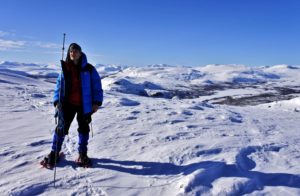My background
My name is Pekka Niittynen. I’m a biogeographer and a PhD candidate from University of Helsinki. Arctic-alpine flora (broadly speaking, including mosses and lichens too) is my passion and has been the research subject for my early scientific career. To be more specific, I study how the cold-adapted northern vegetation will respond if snow conditions change from their current stage. Species distribution models, remote sensing and snow ecology are the keywords to understand what I do.
So far, I have conducted my research in a taxonomic level, meaning that I use species as the base units in my analysis and studies. The TraitTrain course in Svalbard is an obvious step further from such an approach. Instead of using species without any ecological knowledge of them, functional traits are used as proxies how the species (or communities) are interacting with or affecting the environment of the site they accommodate. Species traits are fully comparable between sites and geographical areas, and thus they can be used to answer questions that species-only data cannot. Functional traits are tools to understand and predict how ecosystems work in current and future condition, respectively.
I have spent my last six northern summers conducting field work in Arctic or alpine areas. Yet, Svalbard is waiting to be crossed off my bucket list. Until now. I’m so excited to have the privilege to take part of this year TraitTrain in Longyearbyen. I’m going to hunt down every single plant species new to me and I will absorb all the knowledge about plant functional traits from our experienced teachers and take thousands of photos of our memorable field work days. After the course, my colleague and myself will have two weeks of our own field work campaign at the same area. Therefore, I know that I have completed my study goals if after the course I look the Arctic species communities from a new perspective generating tons of new interesting study questions.
Climate change perceptions in Finland and Svalbard
My studies are closely related to the anthropogenic climate change. The vanishing snow cover will have dramatic effects on tundra ecosystems in ways that we still don’t fully understand. I have followed closely the discussion about climate change issues in Finnish political arenas, and in traditional and social media. To best of my knowledge, an average Finn considers climate change as a major threat to nature and society. The public awareness is probably at a satisfied level but the actions of individuals (myself included) are not always in the line with the concerns.
Also in Finland, however, we have the opposition of climate change deniers. And they are loud, especially in the platforms like Facebook. Skepsis ry is a Finnish association of people sharing a scientific view of the world. However, even their discussion forum on Facebook has been hijacked by few climate change deniers. They seem to wait by their screens and keyboards just to be ready to vomit all their propaganda at the very same moment when someone posts something climate related on the forum. Their tactic is to suffocate the discussion with tons of barely related links, figures and questions. No-one is willing to have discussions like that, so they can treat themselves as winners and the bias has born.
I assume that that the attitude towards climate change is similar in Svalbard as it is in Finland. I think that most of the people living in Longyearbyen are relatively young and highly educated outdoor people. I think all these attributes make them even more aware of the climate change issues. Probably Svalbard have their own loud “skeptics”, but do they have any influence on the general atmosphere? I don’t think so.
Cheers,
Pekka (Twitter)
Niittynen & Luoto. 2018. The importance of snow in species distribution models of arctic vegetation. Ecography, 41: 1024-1037. < https://onlinelibrary.wiley.com/doi/abs/10.1111/ecog.03348 >
